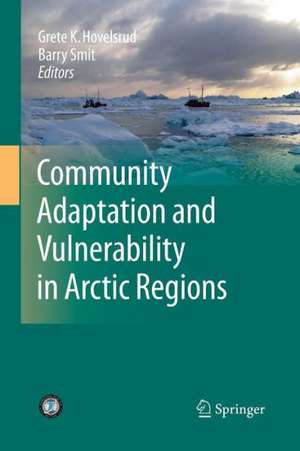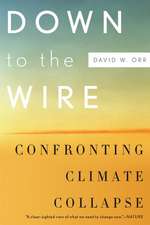Community Adaptation and Vulnerability in Arctic Regions
Editat de Grete K. Hovelsrud, Barry Smiten Limba Engleză Paperback – 6 noi 2014
| Toate formatele și edițiile | Preț | Express |
|---|---|---|
| Paperback (1) | 948.16 lei 6-8 săpt. | |
| SPRINGER NETHERLANDS – 6 noi 2014 | 948.16 lei 6-8 săpt. | |
| Hardback (1) | 952.89 lei 6-8 săpt. | |
| SPRINGER NETHERLANDS – 14 sep 2010 | 952.89 lei 6-8 săpt. |
Preț: 948.16 lei
Preț vechi: 1156.29 lei
-18% Nou
Puncte Express: 1422
Preț estimativ în valută:
181.43€ • 189.94$ • 150.12£
181.43€ • 189.94$ • 150.12£
Carte tipărită la comandă
Livrare economică 05-19 aprilie
Preluare comenzi: 021 569.72.76
Specificații
ISBN-13: 9789400798304
ISBN-10: 940079830X
Pagini: 372
Ilustrații: XVI, 353 p.
Dimensiuni: 155 x 235 x 20 mm
Greutate: 0.52 kg
Ediția:2010
Editura: SPRINGER NETHERLANDS
Colecția Springer
Locul publicării:Dordrecht, Netherlands
ISBN-10: 940079830X
Pagini: 372
Ilustrații: XVI, 353 p.
Dimensiuni: 155 x 235 x 20 mm
Greutate: 0.52 kg
Ediția:2010
Editura: SPRINGER NETHERLANDS
Colecția Springer
Locul publicării:Dordrecht, Netherlands
Public țintă
ResearchCuprins
to the CAVIAR Project and Framework.- Adaptation in Fisheries and Municipalities: Three Communities in Northern Norway.- Vulnerability and Adaptation in Two Communities in the Inuvialuit Settlement Region.- Climate Change, Vulnerability and Adaptation Among Nenets Reindeer Herders.- Vulnerability of Community Infrastructure to Climate Change in Nunavut: A Case Study From Arctic Bay.- ‘Translating’ Vulnerability at the Community Level: Case Study From the Russian North.- ‘As Long as the Sun Shines, the Rivers Flow and Grass Grows’: Vulnerability, Adaptation and Environmental Change in Deninu Kue Traditional Territory, Northwest Territories.- Case Study Photographs.- The Ivalo River and its People: There Have Always Been Floods – What Is Different Now?.- Climate Change and Institutional Capacity in an ‘Arctic Gateway’ City: A CAVIAR Case Study of Whitehorse.- Climate Change Vulnerability and Food Security in Qeqertarsuaq, Greenland.- Climate Change, Vulnerability and Adaptive Capacity in a Multi-use Forest Municipality in Northern Sweden.- Local Effects of Global Climate Change: Differential Experiences of Sheep Farmers and Reindeer Herders in Unjárga/Nesseby, a Coastal Sámi Community in Northern Norway.- Community Adaptation and Vulnerability Integrated.
Recenzii
From the reviews:
“This book aims to present a human approach to understanding the vulnerabilities and adaptive capacities of communities, particularly those in the Arctic, that are experiencing rapid socio-economic and environmental changes. … I recommend this book particularly for Arctic researchers … . The book is also recommended for students in the social sciences, who can increase their understanding of the vulnerability of Arctic communities and apply the framework and knowledge developed by the multidisciplinary team in their studies and future careers.” (Arctic, December, 2011)
“This book aims to present a human approach to understanding the vulnerabilities and adaptive capacities of communities, particularly those in the Arctic, that are experiencing rapid socio-economic and environmental changes. … I recommend this book particularly for Arctic researchers … . The book is also recommended for students in the social sciences, who can increase their understanding of the vulnerability of Arctic communities and apply the framework and knowledge developed by the multidisciplinary team in their studies and future careers.” (Arctic, December, 2011)
Textul de pe ultima copertă
Arctic communities are experiencing global, societal and economic pressurescoupled with additional environmental changes. The comparison of local andindigenous observations with instrumental records clearly illustrates howArctic communities, both now and in the past, have adapted to a variety ofchanges and risks affecting their livelihoods. Projections of future climatechange indicate a further reduction in sea ice extent and stability, changeto the frequency and intensity of weather events and seasonal transition,alteration in the abundance and distribution of fish and terrestrialbiodiversity, and lessening permafrost stability. All these factors willaffect Arctic resident's livelihoods and wellbeing. Under the auspices of the International Polar Year 2007-2008 (IPY), theCAVIAR consortium was formed with partners from all eight Arctic countriesas a response to the need for systematic assessment of communityvulnerabilities and adaptations across the Arctic. The aim of theinterdisciplinary CAVIAR project is to increase understanding of thevulnerability of Arctic communities to changing societal and environmentalconditions, including climate change. Presented in this volume are theresults and accomplishments drawn from the partnership with localcollaborators from fifteen Arctic communities. In each of the case studiesresearchers have documented the conditions and forces that exacerbate ordiminish vulnerabilities in each of the case studies, identified previousand current adaptation strategies, and assess the prospects for thedevelopment of effective adaptive strategies and policies in the future.
Caracteristici
Documents and assesses the nature of vulnerability in communities across the entire Arctic Interdisciplinary research approach Demonstrates the importance of a shared analytical framework for comparing results across case studies Empirical examples of vulnerabilities and adaptive strategies from a region of the world commonly viewed as having high susceptibility to climate change













